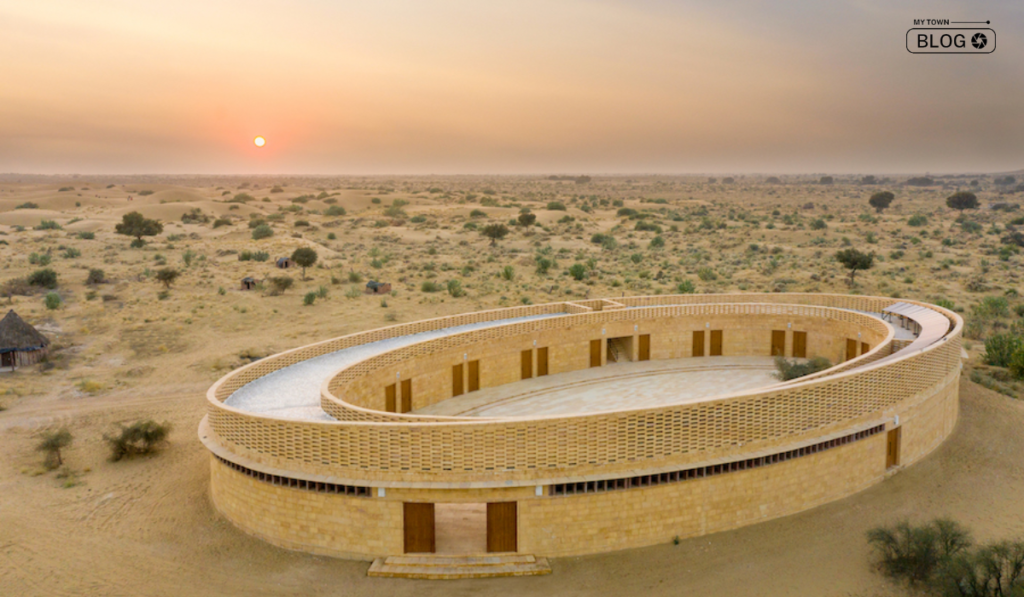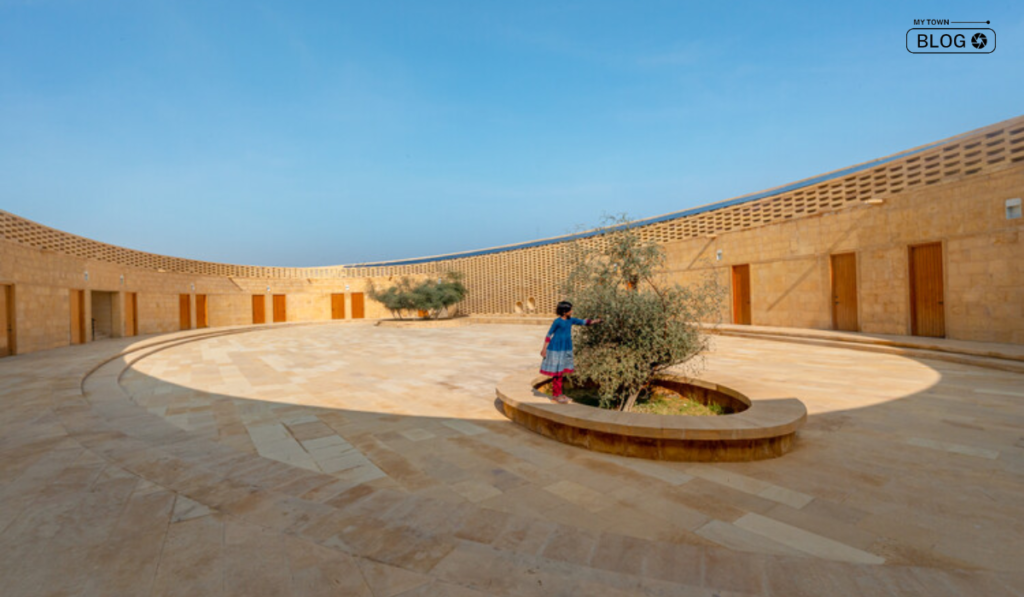Located just six minutes from the renowned Sam Sand Dunes in Jaisalmer lies a captivating architectural marvel in Kanoi village. Imagine a unique educational experience amidst the vast Thar desert at Rajkumari Ratnavati Girls’ School—picture studying in a mesmerizing oval sandstone structure, symbolizing the nurturing embrace of Mother Earth. Despite scorching temperatures and swirling sands, this remarkable school stands resilient, fostering knowledge and empowering girls and women. Discover the strength and beauty that emerges from this extraordinary learning oasis in the desert’s heart. The school was created in July 2021.

Rajkumari Ratnavati Girls’ School
- The GYAAN Center project carefully designed Rajkumari Ratnavati Girls’ School to serve as a cornerstone. Spearheaded by the New York-based firm Diana Kellogg Architects, this innovative endeavor encompasses three interconnected buildings, each serving a distinct purpose.
- The school, designed by Diana Kellogg Architects, is the first building within the GYAAN Center. It is a testament to contemporary and contextually relevant design. Inspired by the natural surroundings, the architecture incorporates sustainable elements while respecting the local culture and traditions. Diana Kellogg, the architect behind the design, sought inspiration from the fluid characteristics of the dunes and the symbols of womanhood they represent.
- The GYAAN Center also includes two additional structures: Medha and the Women’s Cooperative. Medha is a versatile space that combines a performance and art exhibition area with a library and museum. It aims to promote artistic expression and intellectual growth. On the other hand, the Women’s Cooperative serves as a hub for skill exchange, fostering collaboration between local artisans and women.
- These interconnected buildings form a dynamic and holistic environment, providing education, artistic exploration, and economic empowerment. The GYAAN Center celebrates innovation while embracing the region’s cultural fabric, offering a recent initiative that uplifts and empowers the community.
Empowering Women: The GYAAN Center’s Path to Economic Independence
With a strong focus on empowering women through education, the GYAAN Center aims to foster economic independence for women and their families. When envisioning the GYAAN Center, Diana Kellogg, the architect, deliberately incorporated feminine symbols of strength from various cultures into the design process. In her quest to capture the essence of femininity and infinity, Kellogg chose three oval shapes to represent the Jaisalmer region’s dunes, mirroring the dunes’ graceful planes. This thoughtful design approach reflects the center’s commitment to empowering women and creating a space where their potential can flourish.
Local Culture at Rajkumari Ratnavati Girls’ School
- At Rajkumari Ratnavati Girls’ School, we beautifully embrace the essence of local culture through meticulous design choices. The architectural elements, such as yellow sandstone, jalis inspired by the Jaisalmer forts, and the utilization of community labor, pay homage to the region’s rich heritage.
- The incorporation of yellow sandstone, a signature material of the area, not only imparts a distinct aesthetic appeal but also serves as a connection to the surrounding environment. This choice reflects the school’s deep-rooted connection to the local landscape.
- The intricate jalis, inspired by the architectural motifs of Jaisalmer forts, add a touch of elegance to the school’s design. These delicate screens not only enhance the visual appeal of the building but also serve a practical purpose. Providing partial views, privacy, and comfort creates a conducive environment for the girls and women working in harsh desert climates.
Sustainable and Economic Features
- The Rajkumari Ratnavati Girls’ School in Jaisalmer showcases both sustainable and economic aspects in its design. With a focus on supporting girls’ education and preserving the local culture, the architects made deliberate choices to ensure an economically viable plan.
- Diana Kellogg, the architect, emphasized the importance of economic design, given that the school was constructed for a non-profit purpose. Every effort was made to incorporate authentic cultural elements, resulting in a center representing the region and its community members.
- The design of Rajkumari Ratnavati Girls’ School exhibits aesthetic appeal and demonstrates climate responsiveness. The architects considered the extreme temperatures experienced in Jaisalmer, with summer temperatures soaring up to 50 degrees Celsius. Despite this, the school provides a comfortable and ambient study environment. One notable feature is the spacious courtyard, where students can study in the open air, basking in the sunlight during winter without artificial or mechanical climate control.
- By leveraging the natural climate and maximizing outdoor spaces, the school promotes sustainability while minimizing the reliance on energy-intensive cooling systems. This approach reduces operational costs and aligns with the school’s commitment to economic efficiency.
Development of Rajkumari Ratnavati Girls’ School
- The development of School involved a thoughtful and conceptual process driven by a deep understanding of the region’s history, culture, topography, and architectural heritage. Diana Kellogg, the founder of Diana Kellogg Architects, emphasized the significance of effective design as a process rooted in these critical elements.
- Kellogg’s vision was to create a building that embodies light and community and resonates with the soul of the people it serves. The goal was to design a structure that harnesses the natural energies of its surroundings, nurturing and healing the women and girls within it.
- Situated in the mesmerizing region of Jaisalmer, the school’s magnificent elliptical structure seamlessly blends with the surrounding dunes. The curved walls, reminiscent of Rajasthan’s iconic forts, further contribute to integrating the building into its cultural and architectural context.

Conclusion
The Rajkumari Ratnavati Girls’ School showcases an economically designed facility that incorporates authentic cultural elements while prioritizing sustainability. It offers a comfortable and climate-responsive study environment, fostering a harmonious balance between educational excellence, economic viability, and ecological responsibility.
FAQs
What is the purpose of Rajkumari Ratnavati Girls’ School?
Rajkumari Ratnavati Girls’ School aims to empower girls through education, providing them with opportunities for academic growth, skill development, and personal empowerment.
Is Rajkumari Ratnavati Girls’ School a non-profit organization?
Rajkumari Ratnavati Girls’ School is a non-profit organization dedicated to advancing girls’ education and empowerment.
How does Rajkumari Ratnavati Girls’ School support the local community?
Rajkumari Ratnavati Girls’ School supports the local community by offering educational opportunities to girls from the region. It also engages with the community through initiatives that promote skill exchange, collaboration with local artisans, and economic empowerment.
Can visitors or outsiders explore Rajkumari Ratnavati Girls’ School?
Visitors and outsiders may be able to examine school, subject to the school’s policies and regulations. We recommend contacting the school administration or arranging a guided visit to learn more about the possibilities.
Are there any scholarship or monetary aid opportunities for students at School?
School may provide scholarship or financial aid opportunities for eligible students. These opportunities ensure access to education for deserving students, particularly those from disadvantaged backgrounds. You can obtain details regarding scholarships and financial aid directly from the school’s administration or through the school’s official channels.








